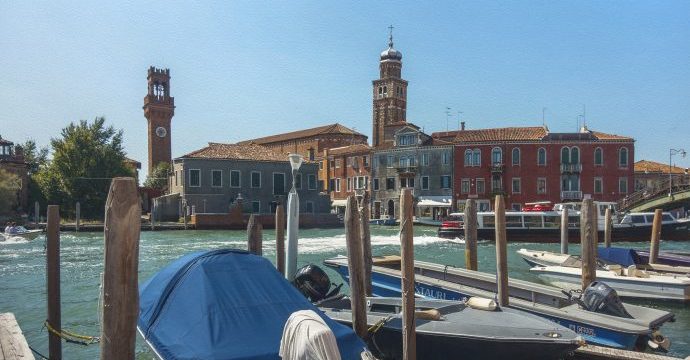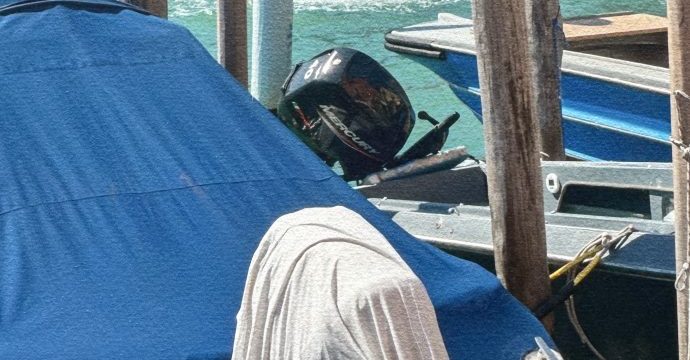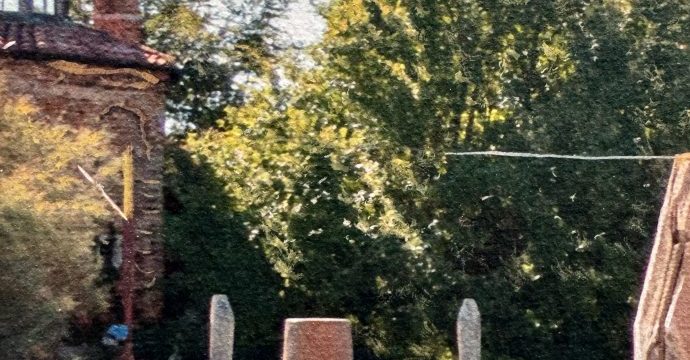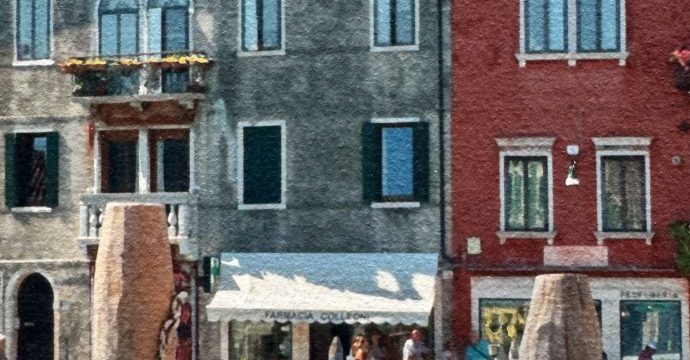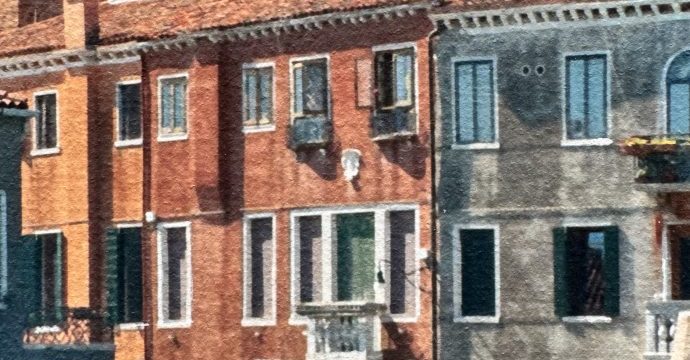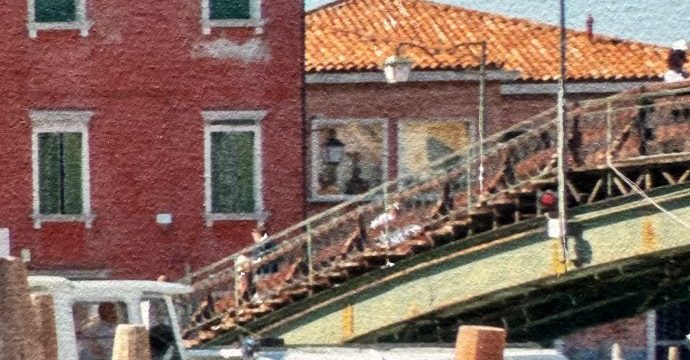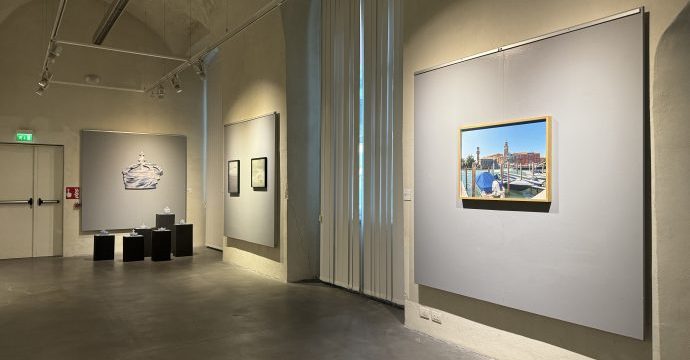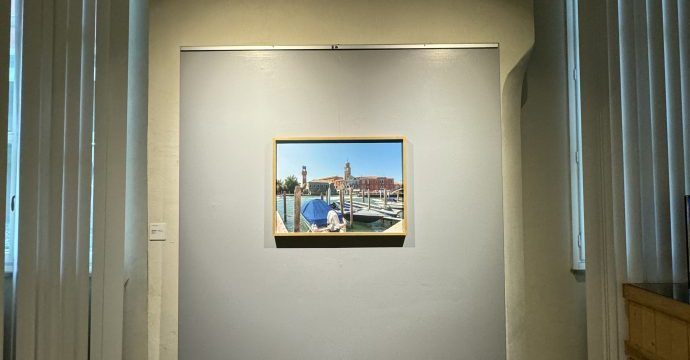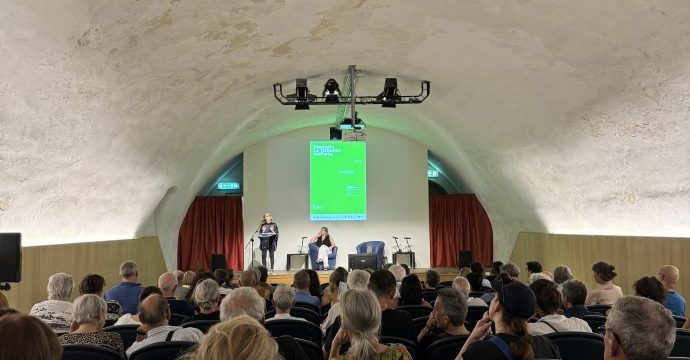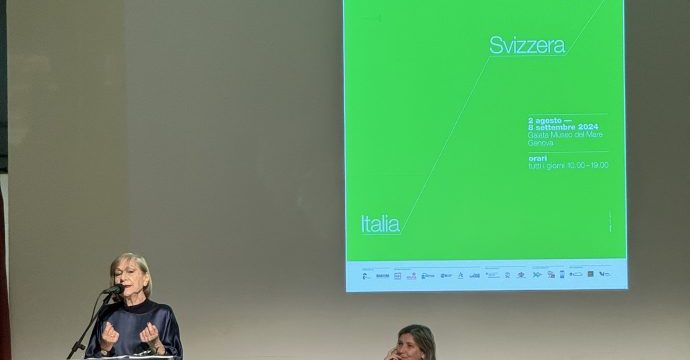Canale Ponte Lungo – Murano – Venezia
- Pier Giorgio De Pinto
- Canale Ponte Lungo – Murano – Venezia
Pier Giorgio De Pinto
“Canale Ponte Lungo, Murano, Venezia”, 2024.
Watercolor and Gouache on paper. 79,3×57,8 cm.
“The Italian/Swiss polysemic multimedia artist Pier Giorgio De Pinto (born in Civitavecchia, 1968, and now living in Chiasso, Ticino) is represented in the exhibition with a work from the series Setting a Landscape entitled Canale Ponte Lungo, Murano, a gouache and watercolour on Hahnemühle cotton paper. Fundamental to his work, both on the material and the conceptual level, is the process, but also the perceptive modality that primarily involves the visual element and, beyond the gaze, haptic, auditory, poietic and visionary sensoriality. What we see in the context of his aesthetic choices is the creation of a Gesamtkunstwerk, a total work of art. The series of which the work on display forms part is based on photographs and freeze-frames from videos that the artist started taking with his own smartphone of landscapes across Europe and the United States in 2018. In this shot of Murano, we can see the stratification of different periods, with the distant tower that harks back to the fourteenth-century tower of Florence’s Palazzo Vecchio in evident dialogue with recognisably Venetian architecture. The engine of the motorboat in the foreground is surprisingly draped in a way that is reminiscent of a seated figure by Leonardo. The outcome of a landscape in which, as in a photograph, the anachronistic detail overexposes effects of reality so exaggerated as to become surreal, arouses a sense of suspicion in the observer while at the same time establishing the perception of an aesthetics of waste that spills over to the point of becoming, à la Bataille, sumptuous.
What is clearly perceptible in Pier Giorgio De Pinto’s work is the contest it sets up between mimesis and fiction, chiasmus-like reversals between analogue and digital, which constantly brushes up against and, at the same time, keeps its distance from the Kosuthian rhetorical device of tautology. In the “taking place” of the work, the artist’s intention is to bring out the genius loci, the intimate spirit of place, in an era in which globalism and virtual reality constantly homogenise it. Given the relationship between man and machine that exists in an advanced technological society, the question arises whether Pier Giorgio De Pinto is addressing the so-called Promethean shame diagnosed by the German philosopher and writer Günther Anders in his 1956 work Die Antiquiertheit des Menschen/ The Outdatedness of Human Beings. A child of the third millennium, Pier Giorgio De Pinto is an artist who constantly challenges the gaze, prompting it to perceive the arte-fact as reality and reality as simulation. The game he plays, which is not only about perception but is also conceptual, is designed to achieve perfection as the culmination of artifice, while still challenging artifice itself as an abyss of the unfathomable. His reproductive ability, which covers both the real and the visionary, seems to find a way to the quantum uncertainty principle. The differences in levels of tension enacted in the figurative field recall Freud’s notion of the uncanny, thus expanding the artist’s own aesthetic territory into the realm of psychoanalysis. The shifts from analogue to digital and vice versa, from the two-dimensional to the haptic, from the conceptual to the physical, from the mind to the hand, spark a sense of disorientation that arises out of the spectral dimension produced by every reproductive means, as Walter Benjamin theorised. Once this enlightening German philosopher has been brought into the conversation, it is difficult – given his seminal 1936 essay The Work of Art in the Age of its Technical Reproducibility – not to ask in what way the works of the Setting a Landscape series by Pier Giorgio De Pinto bring into play the cultural value of aura in a mass consumer society.”
Text by Viana Conti out of the catalogue of the exhibition Biennale Le Latitudini dell’arte – Italy/Switzerland Edition (The Latitudes of Art). Group exhibition at Gàlata, Museo del Mare, (Gàlata Sea Museum), Genoa, Italy.
___________________
Italiano
“L’artista polisemico/multimediale italo/svizzero Pier Giorgio De Pinto (Civitavecchia, 1968, residente a Chiasso, Ticino) presenta in mostra un’opera della serie Setting a Landscape/Ambientazione di un Paesaggio dal titolo Canale Ponte Lungo, Murano, guazzo e acquerello su carta-cotone Hahnemühle. Fondamentale nella sua opera è, sia a livello materiale che concettuale, il processo, ma anche la modalità percettiva che investe in primis il visuale e, al di là dello sguardo, la sensorialità aptica, sonora, poietica, visionaria. Si registra, nell’ambito delle sue scelte estetiche, l’esercizio di una Gesamtkunstwerk, di un’Opera d’arte totale.
La serie di cui fa parte l’opera in mostra scaturisce da fotografie, fermi-immagine da video, ripresi con il proprio smartphone da contesti paesistici sparsi tra Europa e Stati Uniti, a partire dal 2018. Si riconosce, nello scorcio di Murano, la stratificazione di epoche diverse, come la torre lontana che riconduce a quella trecentesca di Palazzo Vecchio a Firenze, in evidente dialogo con riconoscibili architetture veneziane. Un motoscafo, in primo piano, ha il motore sorprendentemente drappeggiato come una figura seduta di Leonardo.
L’esito di un paesaggio in cui il dettaglio anacronistico sovraespone, come in una fotografia, effetti di realtà tanto esasperati da diventare surreali, attiva nell’osservatore uno stato di sospetto, ma, al tempo stesso, introduce alla percezione di un’estetica dello spreco, tanto debordante da risultare, bataillianamente, suntuosa.
Si coglie nell’opera di Pier Giorgio De Pinto una sfida tra mimesi e finzione, ribaltamenti, a chiasmo, tra analogico e digitale, che non manca di sfiorare e, al tempo stesso, prendere le distanze dalla figura retorica kosuthiana della tautologia. È intendimento dell’artista lasciar affiorare, nel farsi luogo dell’opera, il genius loci, lo spirito intimo del luogo, in un’epoca in cui il globalismo, la realtà virtuale, non cessano di omologarlo. A partire dal rapporto tra uomo e macchina, in una società tecnologica avanzata, vien fatto di chiedersi se Pier Giorgio De Pinto si confronti con la cosiddetta vergogna prometeica diagnosticata dal filosofo, scrittore, tedesco, Günther Anders nel libro del 1956 Die Antiquiertheit des Menschen/L’uomo è antiquato.
Figlio del terzo millennio, Pier Giorgio De Pinto è un artista che non cessa di mettere in atto una sfida allo sguardo inducendolo a percepire l’artefatto come realtà e la realtà come simulazione. Il suo gioco non solo percettivo, ma anche mentalmente concettuale, è volto alla perfezione come culmine dell’artificio, sfidando tuttavia la finzione stessa come abisso dell’indecidibile. La sua capacità riproduttiva tra reale e visionario sembra sfociare nel principio d’indeterminazione quantistica. I dislivelli di tensione, messi in atto nel campo rappresentativo, richiamano il Perturbante freudiano, estendendo quindi il proprio territorio estetico in quello psicoanalitico. Gli slittamenti dall’analogico al digitale e viceversa, dal bidimensionale all’aptico, dal concettuale al fisico, dalla mente alla mano, attivano uno spaesamento scaturito dalla dimensione spettrale indotta da ogni mezzo riproduttivo, come non ha mancato di teorizzare Walter Benjamin. Una volta chiamato in causa questo illuminante filosofo teorico tedesco, non ci si può non chiedere – a partire dal suo ineludibile saggio L’opera d’arte nell’epoca della sua riproducibilità tecnica, del 1936 ‒ in quale modalità le opere della serie Setting a Landscape di Pier Giorgio De Pinto mettono in gioco il valore cultuale dell’aura, in una società consumistica di massa.”
Testo di Viana Conti dal catalogo della mostra Biennale Le Latitudini dell’arte – Edizione Italia/Svizzera. Mostra collettiva presso Gàlata, Museo del Mare, Genova, Italia.

